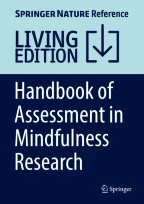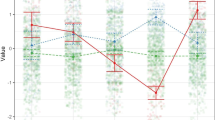Southampton Mindfulness Questionnaire

This chapter provides an overview of the 16-item self-report Southampton Mindfulness Questionnaire (SMQ) that was developed to assess mindful responses to distressing thoughts and images. Theoretical foundations of the scale and its development and initial validation are presented. This is followed by subsequent examination of psychometric properties and information of the scale versions in other languages. Table 1 shows the SMQ in its current version, followed by an explanation of the scoring. The parallel voice version of the SMQ, named Southampton Mindfulness of Voices Questionnaire (SMVQ), is introduced, while the limitations of the SMQ are discussed at the end of the chapter. The SMQ consists of four aspects of mindfulness, identified as mindfulness observation, letting go, absence of aversion, and nonjudgment. The scale developers reported promising psychometric properties and claimed a unidimensional structure of the scale. There have been a limited number of studies that have examined the psychometric properties of the SMQ, and the evidence regarding the scale’s internal validity and reliability has been mixed. The SMQ has Chinese, Spanish, and Dutch versions. Those translated versions, however, have not yet been rigorously validated. The limitation of the SMQ is that the scale may not be suitable for general use as it does not contain items about positive or neutral cognitions and does not assess mindful responses to a wide range of experiences in everyday life.
This is a preview of subscription content, log in via an institution to check access.
Access this chapter
Similar content being viewed by others

Fears and Resistances to Mindfulness: Development of a Self-Report Scale
Article Open access 04 September 2023

The Psychometric Properties of the Portuguese Version of the State Mindfulness Scale
Article 21 October 2019

Unraveling Heterogeneities in Mindfulness Profiles: a Review and Latent Profile Analysis of the Five Facet Mindfulness Questionnaire Short-Form (FFMQ-SF) in the Spanish Population
Article Open access 12 July 2022
References
- Baer, R. A., Smith, G. T., Hopkins, J., Krietemeyer, J., & Toney, L. (2006). Using self-report assessment methods to explore facets of mindfulness. Assessment, 13(1), 27–45. ArticlePubMedGoogle Scholar
- Bergomi, C., Tschacher, W., & Kupper, Z. (2013). The assessment of mindfulness with self-report measures: Existing scales and open issues. Mindfulness, 4(3), 191–202. https://doi.org/10.1007/s12671-012-0110-9ArticleGoogle Scholar
- Brown, K. W., & Ryan, R. M. (2003). The benefit of being present: Mindfulness and its role in psychological well-being. Journal of Personality and Social Psychology, 84(4), 822–848. https://doi.org/10.1037/0022-3514.84.4.822ArticlePubMedGoogle Scholar
- Chadwick, P., Barnbrook, E., & Taylor, N. K. (2007). Responding mindfully to distressing voices: Links with meaning, affect and relationship with voice. Tidsskrift for Norsk Psykologforening, 44(5), 581–587. Google Scholar
- Chadwick, P., Hughes, S., Russell, D., Russell, I., & Dagnan, D. (2009). Mindfulness groups for distressing voices and paranoia: A replication and randomized feasibility trial. Behavioural and Cognitive Psychotherapy, 37(4), 403–412. https://doi.org/10.1017/S1352465809990166ArticlePubMedGoogle Scholar
- Chadwick, P., Taylor, N. K., & Abba, N. (2005). Mindfulness groups for people with psychosis. Behavioral and Cognitive Psychotherapy, 33, 351–359. https://doi.org/10.1017/S1352465805002158ArticleGoogle Scholar
- Chadwick, P. D. J., Hember, M., Symes, J., Peters, E., Kuipers, E., & Dagnan, D. (2008). Responding mindfully to distressing thoughts and images: Reliability and validity of the Southampton Mindfulness Questionnaire (SMQ). British Journal of Clinical Psychology, 47(Pt 4), 451–455. https://doi.org/10.1348/014466508X314891ArticlePubMedGoogle Scholar
- Costello, A. B., & Osborne, J. W. (2005). Best practices in exploratory factor analysis: Four recommendations for getting the most from your analysis. Practical Assessment, Research and Evaluation, 10(7), 1–9. Google Scholar
- Kabat-Zinn, J. (1990). Full catastrophe living: The program of the stress reduction clinic at the university of Massachusetts medical centre. Dell. Google Scholar
- Kabat-Zinn, J. (1994). Wherever you go, there you are. Hyperion Books. Google Scholar
- Kabat-Zinn, J. (2011). Some reflections on the origins of MBSR, skillful means, and the trouble with maps. Contemporary Buddhism, 12(1), 281–306. https://doi.org/10.1080/14639947.2011.564844ArticleGoogle Scholar
- Langer, A., Cangas, A. J., & Fuentes, E. (2012). Applying mindfulness therapy in a group of psychotic individuals: A controlled study. Behavioural and Cognitive Psychotherapy, 40(1), 105–109. https://doi.org/10.1017/S1352465811000464ArticlePubMedGoogle Scholar
- Ledesma, R. D., & Valero-Mora, P. (2007). Determining the number of factors to retain in EFA: An easy-to-use computer program for carrying out parallel analysis. Practical Assessment, Research and Evaluation, 12(2), 1–11. Google Scholar
- Ledesma, R. D., Valero-Mora, P., & Macneth, G. (2015). The Scree test and the number of factors: A dynamic graphics approach. Spanish Journal of Psychology, 18(e11), 1–10. https://doi.org/10.1017/sjp.2015.13ArticleGoogle Scholar
- Perona-Garcelán, S., García-Montes, J. M., López-Jiménez, A. M., Rodríguez-Testal, J. F., Ruiz-Veguilla, M., Ductor-Recuerda, M. J., … Pérez-Álvarez, M. (2014). Relationship between self-focused attention and mindfulness in people with and without hallucination proneness. Spanish Journal of Psychology, 17(e20), 1–8. Google Scholar
- Perona-Garcelán, S., García-Montes, J. M., Rodríguez-Testal, J. F., López-Jiménez, A. M., Ruiz-Veguilla, M., Ductor-Recuerda, M. J., … Pérez-Álvarez, M. (2014). Relationship between childhood trauma, mindfulness, and dissociation in subjects with and without hallucination proneness. Journal of Trauma and Dissociation, 15(1), 35–51. https://doi.org/10.1080/15299732.2013.821433ArticlePubMedGoogle Scholar
- Safran, J., & Segal, Z. (1996). Interpersonal process in cognitive therapy. Jason Aronson. Google Scholar
- Segal, Z. V., Teasdale, J. D., & Williams, J. M. G. (2002). Mindfulness-based cognitive therapy for depression. Guilford. Google Scholar
- Strauss, C., Hayward, M., & Chadwick, P. (2012). Group person-based cognitive therapy for chronic depression: A pilot randomized controlled trial. British Journal of Clinical Psychology, 51(3), 345–350. https://doi.org/10.1111/j.2044-8260.2012.02036.xArticlePubMedGoogle Scholar
- Tavakol, M., & Dennick, R. (2011). Making sense of Cronbach’s alpha. International Journal of Medical Education, 2, 53–55. https://doi.org/10.5116/ijme.4dfb.8dfdArticlePubMedPubMed CentralGoogle Scholar
- Teasdale, J. D., Moore, R. G., Hayhurst, H., Pope, M., Williams, S., & Segal, Z. V. (2002). Metacognitive awareness and prevention of relapse in depression: Empirical evidence. Journal of Consulting and Clinical Psychology, 70(2), 275–287. ArticlePubMedGoogle Scholar
- Van der Valk, R., Waerdt, S. V. D., Meijer, C. J., Hout, I. V. D., & Haan, L. D. (2013). Feasibility of mindfulness-based therapy in patients recovering from a first psychotic episode: A pilot study. Early Intervention in Psychiatry, 7(1), 64–70. https://doi.org/10.1111/j.1751-7893.2012.00356.xArticlePubMedGoogle Scholar
- Wong, A. W. S., & Chen, E. Y. H. (2015). Psychometric properties of translated outcome measures of cognitive behavioural therapy for psychosis in the Chinese context. Asian Journal of Psychiatry, 13, 62–65. https://doi.org/10.1016/j.ajp.2014.09.005ArticlePubMedGoogle Scholar
Author information
Authors and Affiliations
- Oamaru, New Zealand Xuan Joanna Feng
- The University of Auckland, Auckland, New Zealand Yan Chen, Craig S. Webster, Fiona Moir, Jennifer Hobson & Marcus A. Henning
- Xuan Joanna Feng




